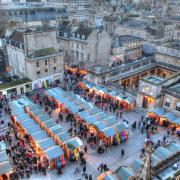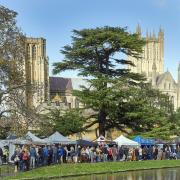There won’t be many people reading this who don’t have a warm fuzzy feeling when they see a pier in a photo or on television.

They’re an essential part of a beach visit as much as donkey rides, soggy sandwiches, gritty swimsuits and being mugged by gulls for your chips.
It’s extremely difficult to avoid the lure of a pier, even if it’s not an all-singing-and-dancing version laden with entertainments – people just have to walk to the end and experience the thrill of being over the sparkling waves and breathing in the sea air – even if you do have candy floss stuck in your hair!
Having kissed at the end of 60 British piers and getting married on Brighton Pier, we’re not alone in being drawn in by the siren song of piers as they have had a special place in the hearts of people ever since their conception.
They were the place to be seen back in Georgian and Victorian times, a place to show off your finery and (sedately) strut your stuff in public. If a seaside town didn’t have a pier, questions were asked! The first seaside pier is generally regarded as being at Ryde on the Isle of Wight. Constructed in 1814 for boats to dock at so that porters didn’t have to carry eminent visitors up the muddy beach on their backs, it was an instant hit, and soon seating, bandstands and refreshment stalls were added to cope with the crowds who wanted to promenade along it. Piers sprang up all over the country; some were built to attract tourists coming in by steamer, others just for people to walk along and enjoy the view, but all were hugely popular. By the late 1800s there were more than 100 of these glorious feats of architecture in existence, each unique, each visited by thousands of people every year.
Now, there are just 60, and some of these grand old ladies such as Queen’s Pier on the Isle of Man grimly hang on for dear life, ravaged by the sea or fire and with insufficient funds to repair them and keep them open to the public. It’s definitely worth taking time to visit some of the surviving piers.
In Somerset there are five, all very different from each other and epitomising the diversity of piers - here you can find short, long, old, new, preserved, derelict and alternative!
For traditional but preserved, you can’t go wrong with Clevedon Pier, built in 1869 and the only Grade 1 listed pier in the country.
It’s one of the most elegant too, its sea-green arches are recycled iron railway rails from an abandoned project of Brunel’s and topped with deliciously ornate shelters and a pagoda where you can enjoy tea and cake. It’s easy to spend an hour or so here – not only are the views across the River Severn exquisite but there are more than 10,000 little brass plaques to read! They are testament to the popularity of this beautiful pier and how hard people have fought to keep it open.
A structural test in 1970 resulted in two spans collapsing and instant closure. It took 28 years of determination to see the pier reopened and now it is a thriving attraction here and a credit to the Clevedon Pier Trust.
Weston-super-Mare is the pier capital of Somerset, where the old, derelict and 10th longest pier in the country (Birnbeck), the newly rebuilt Grand Pier and the alternative (and newest) SeaQuarium reside. Birnbeck was built in 1867 to a design by Eugenius Birch, widely regarded as being THE pier designer of his day.
Essentially an ornate bridge to an island, the pier was frequented by steamers whose visitors enjoyed a jam packed day out on wild rides that included a water chute and swings that flew out over the sea!
Rising costs and increasing maintenance saw this pier close to the public in 1994 (although still a home to the RNLI) and its future hangs precariously in the balance, being bought, sold and neglected time after time. Birnbeck is a pier that is looking for a lottery winner to save it (I keep checking my ticket, but no luck yet!).
Around the corner is the Grand Pier, now holding the largest pier pavilion in the world. It was built in 1904 after the town councillors thought visitors had to walk too far to Birnbeck Pier, relatively late on in the pier building craze.
In its day it was a popular tourist attraction that at different times housed a theatre, water dodgems (a hazardous experience – no splashing please!) and a wooden roller-coaster, although a huge extension out into the channel to entice pleasure boats to visit was abandoned due to the treacherous tides. A fire in 1933 destroyed the pavilion completely – something people all around the world witnessed again in 2008 when a fire of unknown origin developed into an inferno and reduced the pier to charred decking. Undeterred, the pavilion has been rebuilt – bigger, better and definitely a pier for the 21st century!
Sitting quietly and unobtrusively a short distance along the sand is the distinctive diminutive pyramid of the SeaQuarium. Technically it IS a pier, being built on legs out over the beach, and probably the newest pier in the country being constructed in 1995.
If small is your thing, then the fifth Somerset pier is definitely for you, the last stop of our county tour. Burnham-on-Sea has the shortest pier in the country at 36m-long, and although tiny is extremely interesting.
It was built between 1911-14 and was the first concrete pier in Europe. There is little surviving documentation to explain why the pier was built or who designed it . Was the pavilion based on Brunel’s railway station designs at Bristol and Bath? We may never know, but for a bijou pier experience it manages to pack in amusements and all the seaside snacks you could wish for on its diminutive length.
As pier kissers, we’d recommend a visit to each one of these unique seaside ladies, even if you don’t have a kiss at the end! Compare and contrast their charms, step out of the rat race and raise a glass with us – here’s to piers!



























